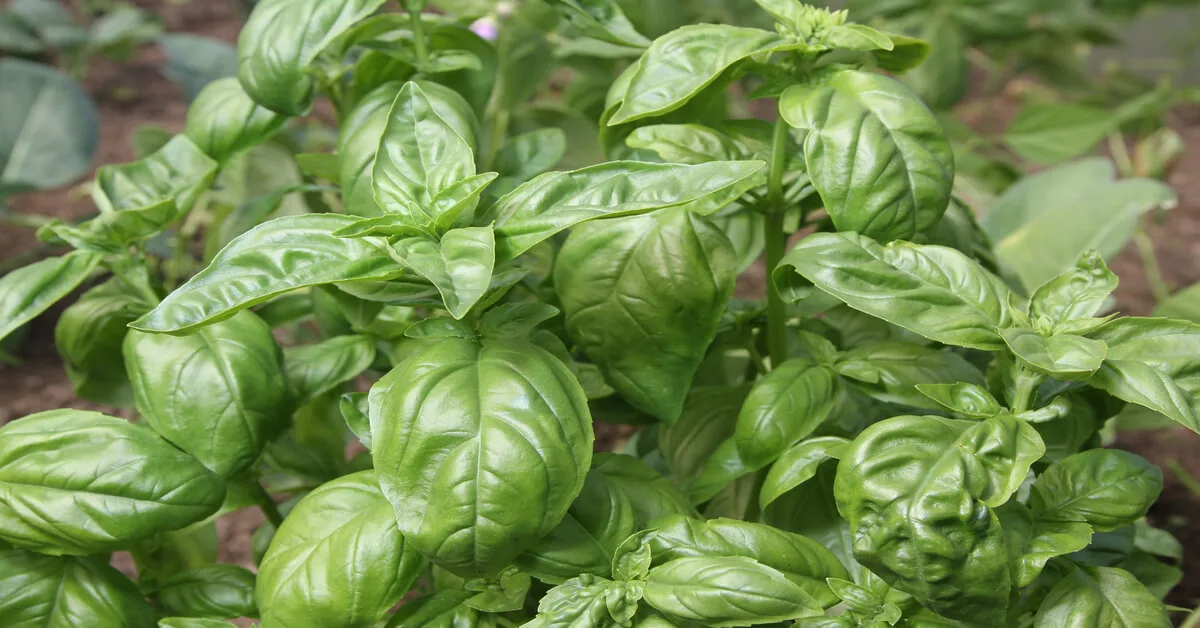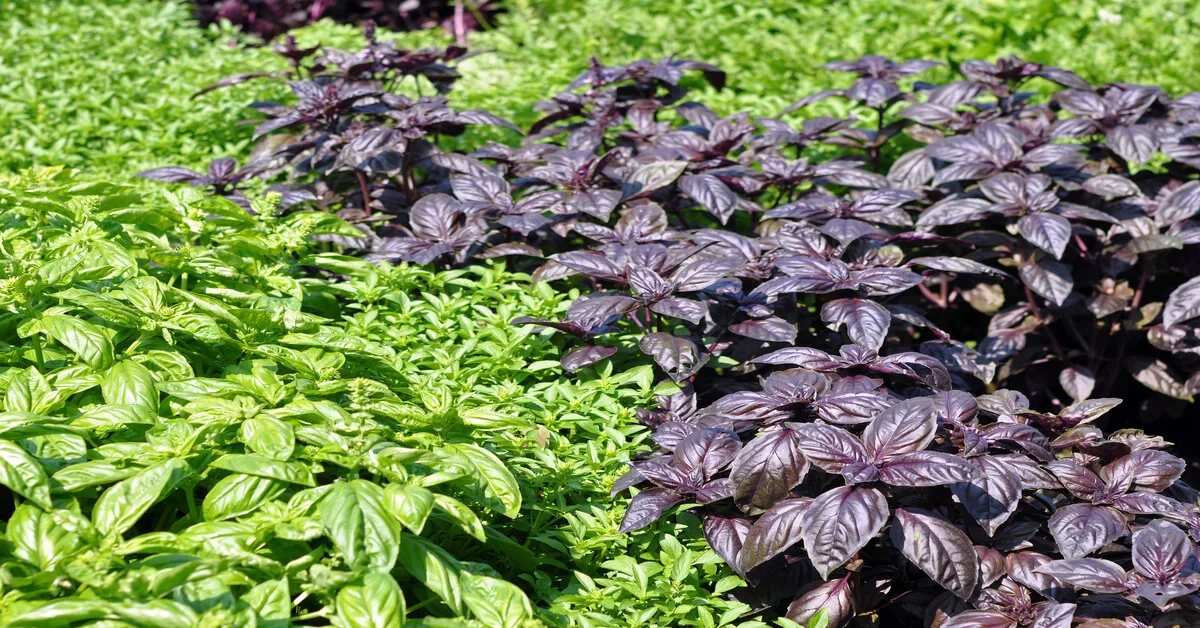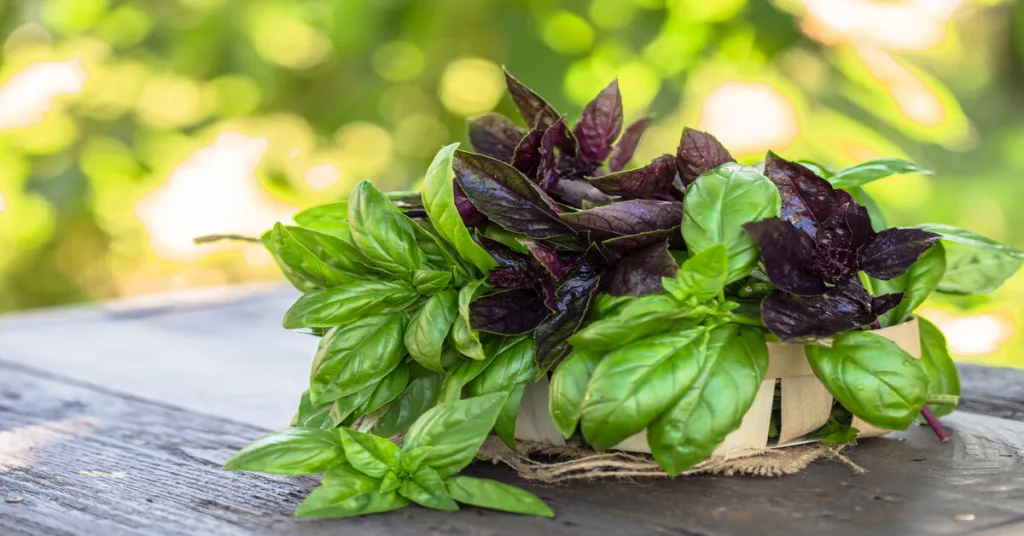Basil, scientifically recognized as Ocimum basilicum, is a beloved herb cherished for its aromatic, flavorful leaves. It is often called sweet basil, highlighting its flavor profile. A go-to plant for culinary enthusiasts and gardeners alike, it brings a delightful aroma and a rich, distinctive taste to various dishes.
Easy to grow in a garden bed or a container, it has an intriguing charm that appeals to everyone, from beginners trying to grow basil to seasoned gardeners.
Origins of Basil Herb
Originating from diverse regions, including Asia and Africa, basil now boasts a global presence. It’s a key player in the traditional cuisine of many nations – Italy, Thailand, India, Vietnam, and more.
From the sweet basil of Italian kitchens to the spicier Thai basil in Asian fare, this adaptable plant graces the gardens and kitchens of homes worldwide.
Basil Characteristics
Plants can vary in size, growing to heights of 12 to 24 inches tall, contingent on the type of basil and its growing conditions. Each plant showcases leaves that span 2 to 3 inches long, feeling soft and smooth when touched.
The color spectrum of basil leaves varies from the bright green of sweet basil to the purple basil’s deeper hues. During its growing season, the basil plant also produces tiny white flowers, adding a further element of beauty.
Growing Basil Plant Care

Soil
Basil thrives in well-draining soil enriched with organic matter. Adding compost to your garden soil or potting mix enhances its nutritional content and promotes better drainage. Remember, basil likes its soil moist but not waterlogged.
Watering
Plants need moderate watering. If the top inch of the soil is dry, it’s time to water your basil plant again. Overwatering can lead to root rot, so letting the soil dry out between watering sessions is essential.
Lighting
Basil plants need about six to eight hours of sunlight each day, indoors or in a garden bed. Ensure they are placed in a sunny spot to soak in ample daylight.
Humidity & Temperature
Basil loves warm conditions, ideally between 60 to 75°F. As an annual plant sensitive to frost, indoor basil plants should be kept away from chilly drafts. Basil plants need a moderate humidity level, making them suitable for most homes without additional humidity control.
Fertilizing
Benefits from regular feeding with a balanced plant food with an NPK ratio of 10-10-10. Apply this every four weeks during the growing season to support optimal growth. Organic options, like compost or worm castings, can also be effectively used.
Propagation Techniques
Basil can be propagated from seeds or cuttings. Plant basil seeds indoors six weeks before the last spring frost for seed propagation. Once the seedlings are 2-3 inches tall and have a set of true leaves, they can be transplanted outdoors or to a larger pot indoors.
For propagation through cuttings, choose a healthy stem, and cut it just below a leaf node. Remove the leaves from the bottom part of the stem and place them in a glass of water. Within a week or two, you will see new roots sprouting. The rooted cutting can then be transplanted into a pot or garden bed.
Diseases & Pests
Basil can be susceptible to diseases such as fusarium wilt and downy mildew. Pests such as aphids, Japanese beetles, and whiteflies can also infest basil plants.
Regular inspection and organic pest control measures can help keep these issues at bay. Remember, maintaining good air circulation and watering at the soil level can prevent many diseases.
Harvesting Your Basil
Harvesting basil is an exciting step, allowing you to savor the fresh basil flavor in your dishes finally. The right time to harvest basil is just when the plant is about 6 to 8 inches tall. You can start by plucking a few leaves from the top to stimulate bushier growth.
Generally, it’s best to harvest your basil regularly throughout the growing season. This practice encourages the plant to grow more leaves and prevents it from going to seed, extending its lifespan. Ideally, it would help if you aimed to prune or harvest one or two basil plants at a time.
When harvesting, take your fingers and pinch the stem just above a leaf set. This encourages the plant to produce two branches from where you pinched it, resulting in a fuller plant over time.
For a significant harvest, wait until just before the plant starts to flower. At this stage, the leaves will have the highest concentration of oils, providing maximum flavor. If you notice a flower bud, pinch it off right away. Flowering changes the taste of the basil leaves, making them bitter.
Once you’ve collected the basil leaves, rinse them under cool water. You can use them immediately or store them for later use. Fresh basil leaves can be stored in a glass of water or wrapped in a damp paper towel inside a plastic bag in the refrigerator. For more extended storage, you can dry or freeze the basil leaves.
Types of Basil

Sweet Basil
Sweet or Genovese basil is the most prevalent variety in many home gardens. This basil boasts large, fragrant green leaves, adding sweetness to Italian cooking.
Thai Basil
Thai basil stands out with its spicy taste profile. Purple stems and smaller, narrower leaves are a staple in numerous Southeast Asian dishes, enriching them with a unique kick.
Lemon Basil
As the name suggests, lemon basil has a distinctive citrusy aroma and flavor. Its light green leaves and enticing fragrance make it an excellent addition to Thai and Indonesian cuisines.
Purple Basil
Purple basil also recognized as ‘Dark Opal’ basil, surprises with its dark purple leaves. This type of basil lends a pop of color and a mild flavor to salads and vinegar, adding an exciting twist.
Basil Companion Planting
Basil is commonly used in companion planting for its many benefits. Here are a few plants that basil is planted with.
Tomatoes: Basil and tomatoes are a classic pairing in the garden and kitchen. It is said to improve the flavor of tomatoes, and the aroma helps repel pests that might damage tomato plants.
Peppers: Help improve the health and flavor of peppers while deterring pests that can attack pepper plants.
Asparagus: Basil helps deter pests and improves the flavor of asparagus.
Rose’s: Improve overall health and pest management of roses.
Conclusion
Learning how to grow basil can be an enriching experience. With its versatility and ease of care, this fragrant herb makes it a perfect addition to your indoor or outdoor garden.
When you care for basil correctly, the plant rewards you with a continuous supply of fragrant leaves ready to transform your culinary creations. Just remember the essential care tips: Basil likes well-draining soil, regular watering but not overwatering, plenty of sunlight, and a good feed now and then.
Mulching around your basil plants can help retain soil moisture, suppress weeds, and cool the root system. An inch or two of organic mulch, like compost or shredded leaves, can do wonders for your basil plants.
With this comprehensive guide, we hope you feel confident to start your basil-growing journey. So, don’t wait any longer. Start planting your basil seeds or seedlings, care for them, and soon enough, you’ll enjoy fresh, homegrown basil.
Ultimately, the joy of gardening comes from the process as much as the results. The more you learn how to grow basil and care for it, the more you’ll appreciate this wonderfully aromatic and flavorful herb.

